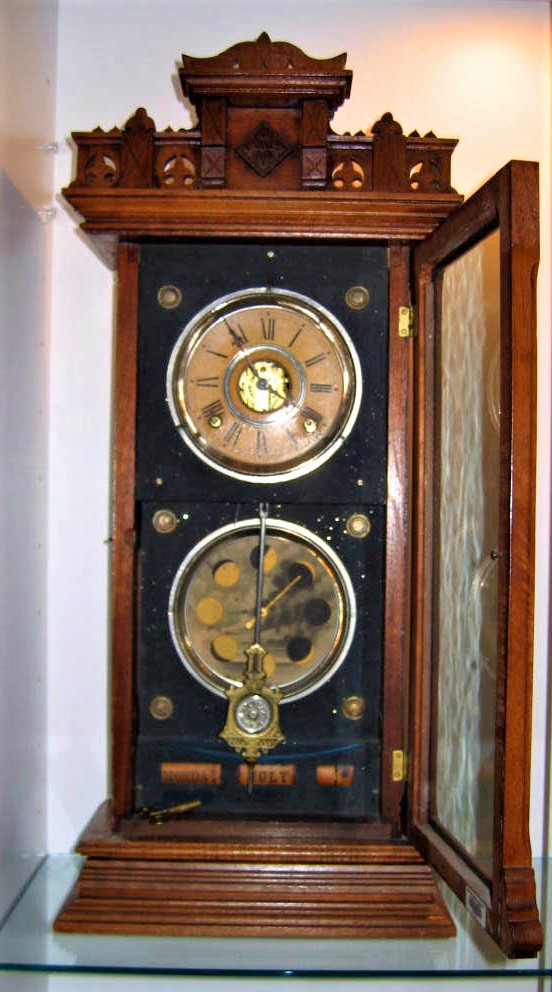By Heather Munro
The Macomb Calendar Clock is a “perpetual calendar clock” that displays not only the time with the hands on the clock face but also shows the month, the day of the week, and the date. In addition, the clock shows the phase of the moon with a painted picture of the moon on a rotating disk. Amazingly enough, the Macomb Calendar Clock can even automatically correct for uneven months and will also correct for the leap year! All these features are from a clock that is over a hundred years old, has no power source other than being wound by hand, and uses only a pendulum, a swinging weight, as its timekeeping element!
The Macomb Calendar Clock was the brainchild of Mr. Josiah Seem, a jeweler who moved to Macomb in 1871. That same year he established a store on the courthouse square. Mr. Seem was not only a jeweler but also an inventor. In 1881, he invented a unique calendar clock mechanism that was slightly different from others being made at the time. The next year, in 1882, he and other businessmen in town organized the Macomb Calendar Clock company to make calendar clocks with this special mechanism. The factory to make the clocks was located on South Lafayette Street just off the southwest corner of the square. Production of clocks began around July 1882. The factory was a busy place and by January 1883 had produced 500 clocks. But about six months later, in July of 1883, production was halted after making a total of 1,000 clocks. The clock factory building was torn down in 1885.
The Macomb Calendar Clock Company produced clocks for just two years, 1882 and 1883. Only 1,000 clocks were ever produced making the clock on display quite rare, one of only one thousand ever made. Company records are not clear as to what exactly happened and why the factory shut down. One contributing factor seemed to be the lack of a distribution system for selling the clocks. Perhaps income from sales did not keep up with the expenses of operation.
Whatever mysterious events occurred, after 1883 there was no longer a Macomb Calendar Clock company in Macomb. What exactly happened to the 1,000 clocks made and where did they all go? Some clocks stayed in this area (about 40 are known to be in this region) but others have roamed far and wide. Antique clock historians have estimated that based on known clocks only about 10% of the production still survives or about 100 clocks. From time to time Macomb Calendar Clocks show up in auctions. In 2006, a Macomb Calendar Clock appeared at an auction at the Mebane Antique Auction Gallery, in Mebane, North Carolina, and sold for $3,600.00.
The company produced ten different styles of clocks: shelf models and wall models, small ones with five-inch dials, and larger ones with six-inch dials. All of the clocks had the special calendar mechanism invented by Mr. Seems. The main distinctions in the different styles of clocks were their sizes and the carving of the cases. The only advertisement ever printed for the clocks calls them “the most useful and handsome clock made”.
A beautiful example of what the Macomb Calendar Clock Company produced, the clock on display at the museum is one of the smaller clocks created by the company having a 5-inch dial with Roman numerals. It is a type called a “shelf clock” or “mantle clock”, made to sit on a shelf or mantle. All pendulum clocks must remain stationary on a flat surface or hung on a wall as any movement will affect the motion of the pendulum, causing inaccuracies. The clock case is made from black walnut, a wood that has always been highly prized for being heavy and strong, yet easily split and worked, perfect characteristics for a clock case. Although this is a mass-produced item craftsmanship is evident in the details. An example of the detail work is found in the design of the clock part called the “pendulum bob”, which is the circle at the bottom of the rod that swings back and forth, made of brass with a nickel center. Intricately fabricated, for no other reason than to delight the eye, the bob has been made to resemble a stylized oncoming locomotive. The attractive carving at the top of the clock case features leaves and fleur-de-lis. Even though this clock was made in a factory obvious care was taken to create a useful thing of beauty that an owner would be proud to display in their home.
Want to know more about the Macomb Calendar Clock Company? Check out the fascinating book, The Most Useful and Handsome Clock Made written by Jarrel Hofer in the Museum’s Reference Library. This book is chock-full of everything to know about the company.
Copyright Western Illinois Museum, 2008

